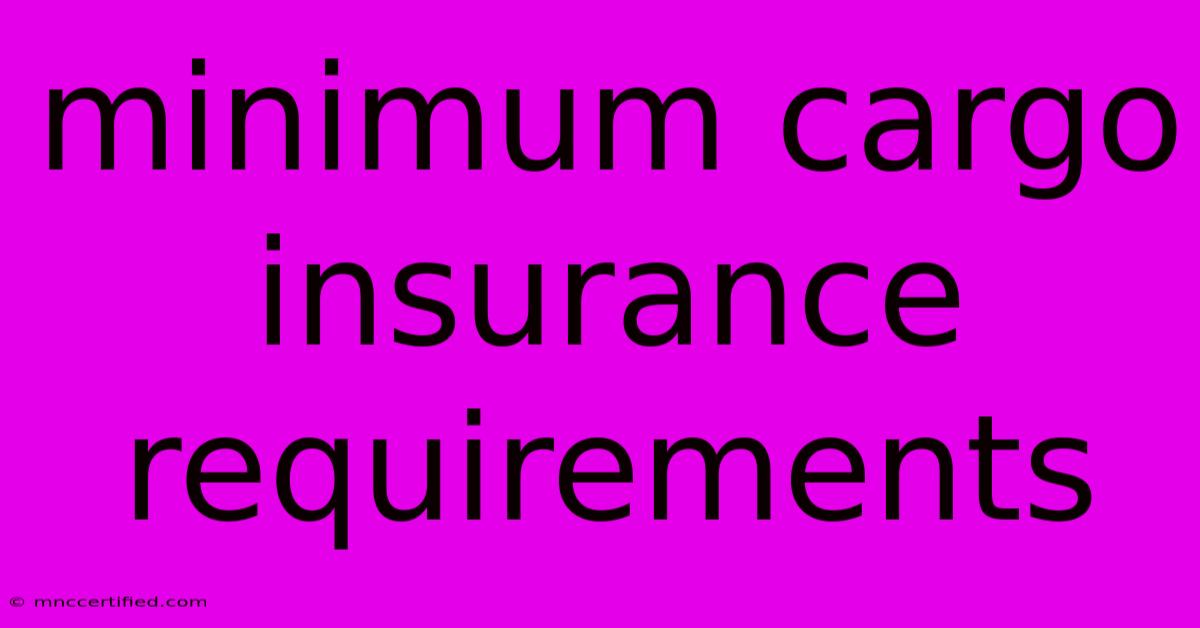Minimum Cargo Insurance Requirements

Table of Contents
Minimum Cargo Insurance Requirements: A Comprehensive Guide
Shipping valuable goods? Understanding minimum cargo insurance requirements is crucial to protect your investment in case of unexpected events during transit. While specific requirements vary depending on factors like the type of cargo, shipping route, and carrier, this comprehensive guide will provide insights into the basics and help you navigate the complex world of cargo insurance.
Why Is Cargo Insurance Necessary?
Cargo insurance acts as a safety net, shielding you from financial losses arising from:
- Damage or loss due to accidents: Collisions, capsizing, derailments, or other unforeseen incidents can damage or destroy your goods.
- Natural disasters: Storms, floods, earthquakes, and other natural calamities can disrupt shipments and lead to significant losses.
- Theft or pilferage: Your cargo could be stolen or partially pilfered during transit, leaving you with a substantial financial burden.
- Other perils: Risks like fire, explosion, and even improper handling during loading or unloading can damage your goods.
Understanding the Minimum Requirements
The minimum cargo insurance requirements are often dictated by:
- The carrier's terms and conditions: Many shipping companies will require a minimum level of insurance coverage for the goods they transport.
- Incoterms: International Commercial Terms, such as CIF (Cost, Insurance, and Freight), specify which party is responsible for insuring the goods.
- Legal requirements: Certain countries or regions may have regulations specifying minimum insurance coverage for specific types of cargo.
Key Types of Cargo Insurance Coverage
While the specific coverage options may differ depending on your insurance provider, here are some common types:
1. All Risks Coverage: This comprehensive policy covers a wide range of perils, including accidents, natural disasters, theft, and even mishandling. It offers the most comprehensive protection, but premiums are typically higher.
2. Named Perils Coverage: This policy only covers specific risks listed within the policy, offering lower premiums but limited protection.
3. Total Loss Only Coverage: This basic coverage only reimburses you for the total loss of your cargo, not for partial damage or theft. It is the most economical option but provides the least protection.
4. Specific Coverage: You can also obtain additional coverage for specific risks like spoilage, contamination, or delay, depending on your needs and the nature of your cargo.
Determining the Right Coverage for You
Several factors influence the minimum cargo insurance requirements you should consider:
- Value of the cargo: Higher-value goods require greater insurance coverage.
- Shipping route and mode of transport: Longer or more challenging routes increase the risks and may necessitate higher insurance limits.
- Type of cargo: Certain goods, like fragile electronics or perishable items, require specialized coverage.
- Your risk tolerance: Determine your comfort level with potential losses and choose a policy accordingly.
Essential Tips for Obtaining Adequate Coverage
- Contact a reputable cargo insurance provider: Choose a provider with expertise in international shipping and a proven track record.
- Clearly communicate your needs: Explain the type of goods, shipping route, and desired coverage level to your insurance provider.
- Thoroughly review the policy terms: Pay close attention to exclusions, limits, and deductibles before signing.
- Maintain accurate records: Keep detailed documentation of your cargo's value and shipping details for insurance claim purposes.
Conclusion:
Navigating the complexities of minimum cargo insurance requirements is crucial for protecting your investment. By understanding the different types of coverage, factors influencing requirements, and key tips for obtaining adequate protection, you can confidently navigate the world of shipping and minimize potential financial losses.

Thank you for visiting our website wich cover about Minimum Cargo Insurance Requirements. We hope the information provided has been useful to you. Feel free to contact us if you have any questions or need further assistance. See you next time and dont miss to bookmark.
Featured Posts
-
Unsafe Driving Nj Insurance Increase
Nov 12, 2024
-
Barcelonas Attack Hit Yamal Lewandowski Out
Nov 12, 2024
-
Camilla King Charles Problem In New Doc
Nov 12, 2024
-
Toilet Tower Defense Trading Website
Nov 12, 2024
-
Prime Minister Starmer At French Armistice
Nov 12, 2024